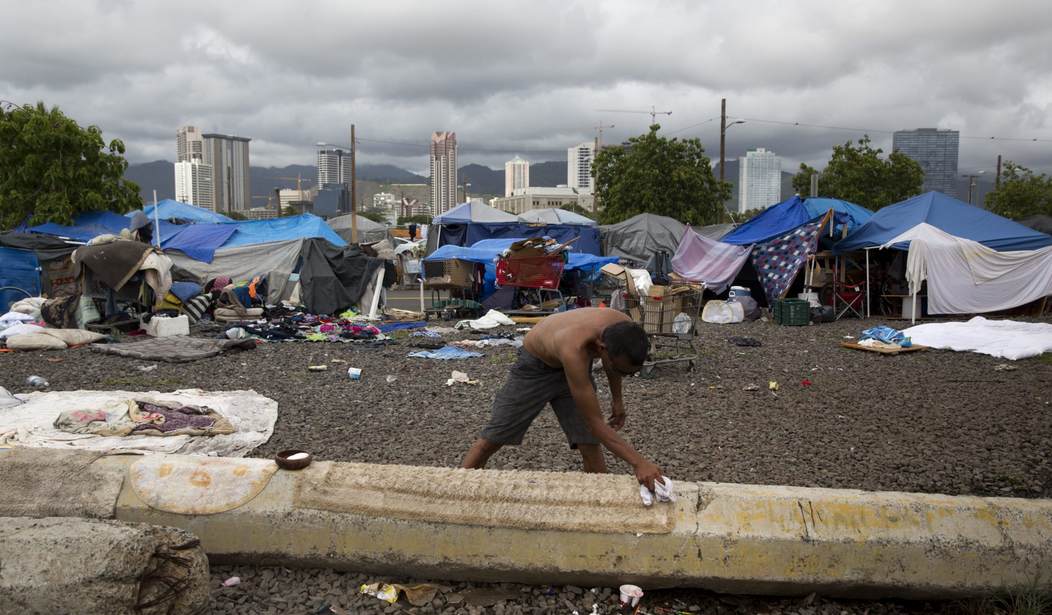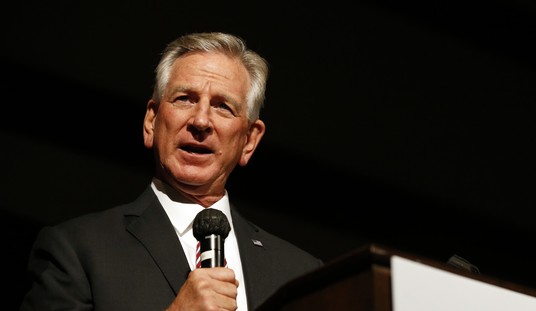Kakaako Waterfront Park on the island of Oahu has been closed indefinitely in order to repair the damage done by a large homeless population that has been camping there in makeshift huts and tents. This is an unprecedented move by the state of Hawaii. The Honolulu Star-Advertiser has details about the massive damage and public safety hazards in the park.
“[P]ark officials say they can no longer ensure the safety of park users following a recent series of dog bites, fires and vandalism attributed to an estimated 180 homeless people living along the Kakaako shoreline….Right now, with dog attacks and exposed wires and broken plumbing, it’s just not safe,” the report explained.
The beautiful islands of Hawaii harbor a longstanding but growing problem: Homelessness is a plague that seems to have no solution. Hawaii’s beaches are its lifeblood, the draw for millions of tourists who keep Hawaii going. The beaches are also all public, a point of contention with many big hotels that would like to have private beaches for their clientele but are not allowed to by state law. This high regard for public access to all Hawaii beaches makes the move by the state to indefinitely close off Kakaako Park even more unusual and upsetting to residents. Fearing blowback and public shaming for speaking out, residents would only speak to PJ Media using pseudonyms. “Bonnie,” born and raised in Honolulu, voiced her frustration at the care the homeless receive while taxpayers foot the bill.
“People are so concerned about the homeless — who will be concerned for the middle class? The homeless steal, and in effect they literally steal public places by living there; they steal private land by living there,” she complained. “They pick prime oceanfront parks to live and dare the rest of us to sound cruel when we say enough is enough. We play by all the rules, they play by none. Our community had to hire private security at our own cost to remove homeless encampments from our private property to keep the drugs and human waste out of our communities. They were using our yards as toilets, spreading disease, and the state wouldn’t do anything.”
Hawaii is one of the most expensive places to live. There is no such thing as affordable housing there unless you get government assistance. Because of this, and many other issues such as drug addiction and mental illness, the homeless population has grown to around ten thousand people in Hawaii living on the streets. The homeless at Kakaako Park have made that beach a nightmare for the public to visit as it became rife with human waste, wild dogs, and downed electrical wires they had pulled out of poles to wire their tents.
PJ Media reached out to Scott Morishige, the governor’s coordinator on homelessness, for more information. “One of the things to understand about this part of the island is that there are homeless who have been in this area for 10 years or longer,” he explained. “Realistically, when the parks reopen there will be homeless still there,” Morishige admitted.
The state has no long-term solution for the homelessness issue. They seem to do raids when the encampments get too dangerous or the public health is at risk, then spend large amounts of money to clean it up and then reopen for the homeless to come back. This cycle repeats every year. Hawaii is under complete Democrat control, in case you were wondering.
https://youtu.be/VbdT-_co19U
Despite many homeless outreach programs, the state is falling farther and farther behind in housing eligible homeless families.
Mike Goodman of the Hawaii Kai Homeless Task Force spoke to PJ Media about the ongoing problems. “You can’t applaud yourself if you housed 750 people in a year when you are still doing worse than the captain on the Titanic,” he said. “It’s not that they aren’t working hard or accomplishing things but they need to broaden their thinking.”
Goodman has put forward many ideas on solving the immediate problem of unsafe conditions and the takeover of public spaces, but they have fallen on deaf ears. Through his research he believes he has come up with a solution in the form of dome villages that will lead to greater independence for the homeless and relief for the residents of Hawaii who have grown tired of catering to the homeless population.
“Many of the homeless coordinators and service providers don’t like the idea of homeless tent camps because of the ghetto stigma,” said Goodman. “But they fail to understand it can’t be worse than it is now. You need to create harm reduction for everyone including taxpayers and get them off public spaces and away from tourist destinations.”
Goodman believes that there are ways to alleviate the human suffering and the criminal behavior. “The answer is that we have to use the penal code. If someone wanted to live on the street without hurting anyone or littering or causing any trouble no one would care,” he said. “It’s impossible to live this way on the street without committing crimes. Most of these people get long criminal records and are cycled in and out of jail, but the threat of jail has to be there to teach consequences for lawbreaking.”
Goodman continued, “Their sentences can be used to force them to go into a dome village where they can be monitored by social services and cared for. A program in Hawaii called Hope Probation has success rates that are 60 to 70% and recidivism is only 40%. The probationers are closely supervised and given lots of supportive services, but if they violate the terms they are sent to jail for a few days immediately and then given another chance. There was a study done that showed 70% thanked the program for helping them get their lives together. They need a place where they can live and have hygiene centers there.”
Studies have shown that people addicted to drugs are less likely to be rehabilitated without a stable home environment. Shelters do not help. “Imagine if you are mentally ill or on drugs and a shelter is the only place you can go but you can’t stay there during the day. You must wander all day long with all of your belongings until nightfall. This is not a workable solution for people who are sick. They need stability,” said Goodman.
Morishige hinted that the governor may finally be looking seriously at Goodman’s ideas. “One of the things that happened is the legislature passed Act 212 on homelessness to look at the issue of safe zones,” he said. “There is a meeting of a working group this month to address the problem. Hawaii County in Kona is a legal encampment that the county had set aside for homeless structures and tents with security. We are looking at that. Dignity Village in Oregon is another example we are studying and other projects in Honolulu with modular structures are all options for the 2018 session.”
Residents remain skeptical. Matthew, a lifelong resident and native Hawaiian, doesn’t think handing out homes is the answer. “With each handout and permissive attitude by the government, more take advantage. It creates more homelessness, not less.”
The problem is a difficult and complex one with no easy answers, but one thing is for sure. Hawaiians are growing angrier with each passing day that the status quo remains and their public parks and tourism are decayed by crime, violence, and drugs.










Join the conversation as a VIP Member